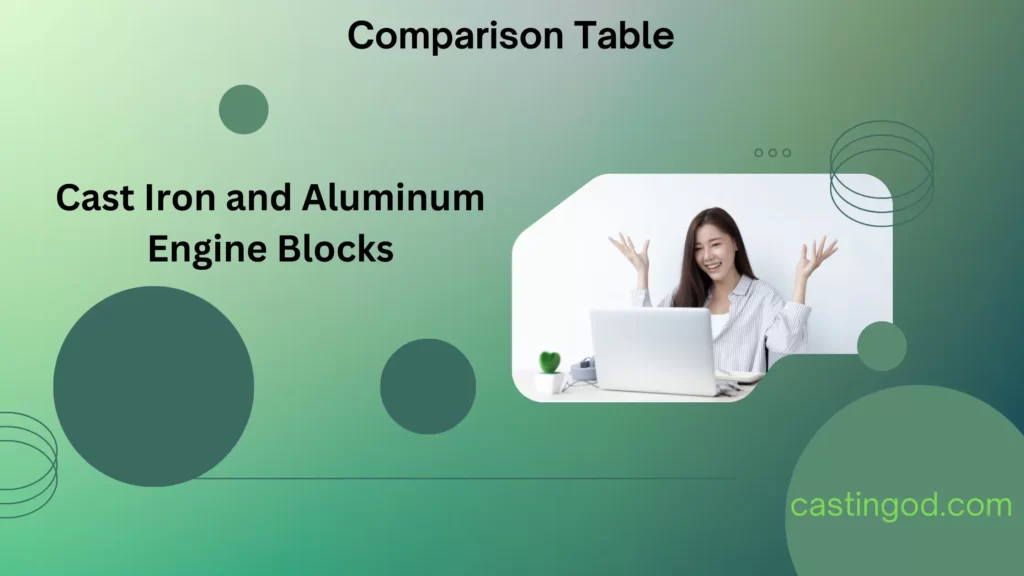The engine block is also known as a cylinder block. The engine’s basic structure provides a place for the cylinders. Additionally, it provides channels for coolant, exhaust, and intake gases to flow over the machine and hosts the crankcase and camshafts. In modern engines, the block is the primary enclosure for hundreds of parts.
It is also the most significant component in total engine parts, contributing 20% to 25% of its overall weight. Siegfried Marcus created the first effective internal combustion engine that could be used in a car in 1864. It had an upright, two-stroke, single-cylinder gasoline engine.
What material do engine blocks consist of? Cast iron and aluminum are the materials used to construct the engine blocks.
Cast Iron Engine Blocks

Grey cast iron is commonly used in the production of engine blocks. Cast iron with a graphitic microstructure is known as gray cast iron. Its gray color, brought on by the presence of graphite, is the source of its name.
Grey cast iron is one of the most cost-effective forms of iron and is used in a wide range of machinery across many sectors. Similar to bicycle gears, motorcycle gears are constructed of gray cast iron.
The following are the constituents of gray cast iron.
- Constituents
- Gray Cast Iron
- Silicon 1-3 %
- Manganese 0.2–1%
- Sulfur 0.02–0.25 %
- Phosphorus 0.02–1 %
Advantages:
Grey cast iron engine blocks are created comparatively cheaply. Grey Cast Iron also offers good machinability, good galling resistance, and good wear resistance. These engine blocks’ tensile strength is also higher than that of aluminum engine blocks.
Disadvantages:
Cast iron engine blocks have a lot of weight, their biggest drawback. The importance of the engine has a significant impact on how well motorcycles function—extensive weight results in higher fuel consumption and pollutants, which are reduced in aluminum engine blocks.
Aluminum Engine Blocks
Aluminum alloys 319, A356, and A357 are commonly used in aluminum engine blocks.
These aluminum alloys are not strong enough to serve as an engine block. Therefore, these alloys go through a T5 or T6 heat treatment to get the required strength for manufacturing.
With the heat treatment, these alloys would be sufficiently fragile and appropriate for engine blocks. The heat treatment of aluminum alloys is, therefore, essential.
Tensile strengths for aluminum alloys 319, A356, and A357 typically range from 10,000 to 14,000 psi.
These aluminum alloys’ compositions are as follows.
Constituents
- 319
- A356
- A357
Aluminum
- 85.8–91.5 %
- 91.1–93.3 %
- 90.8–93 %
Silicon
- 5.5–6.5 %
- 6.5–7.5 %
- 6.5–7.5 %
Magnesium
- 0.1%
- 0.25–0.45 %
- 0.4–0.7 %
Copper
- 3–4 %
- 0–0.2%
- 0–0.2%
Titanium
- 0.25%
- 0–0.2%
- 0.04–0.25%
Iron
- 1%
- 0.2%
- 0.2%
Zinc
- 1%
- 0.1%
- 0.1%
Nickel
- 0.35%
Manganese
- 0.5%
Advantages:
Engine blocks made of aluminum weigh less than cast iron ones. Motorcycles with aluminum engine blocks have reduced emissions and higher fuel efficiency due to their lightweight construction.
Disadvantages:
Aluminum alloys are more expensive and have worse machinability than gray cast iron. Even after heat treatment, they still have a lower tensile strength than cast iron engine blocks.
Comparison Table of Cast Iron and Aluminum Engine Blocks
The following comparison table shows the differences between cast iron and aluminum engine blocks.
| Parameters | Gray Cast Iron | Aluminum Alloy |
| Weight | High | Low |
| Manufacturing Cost | Low | High |
| Fuel Efficiency | Low | High |
| Wear Resistance | High | Low |
| Noise & Vibrations | Low | High |
| Ease of Repair | Difficult | Easy |
| Rebuilding | Easy | Difficult |
Manufacturing Process of Engine Blocks
Sand casting is mainly used to produce engine blocks. Although die casting is also possible, die castings degrade quickly, and sand casting is far more cost-effective.
Aluminum alloys react in the air to generate aluminum oxides, making the process of casting aluminum in the sand challenging in the past. However, as time passed, casting technology incredibly advanced, making it simple to cast aluminum.
Some companies use cast iron in the liner or another area of the engine block since aluminum engine blocks are less robust than cast-iron blocks.
Additionally, reinforcement frames are incorporated into the design of the blocks to increase the durability of the aluminum engine blocks. When the casting process is complete, the engine block is taken for further machining and surface polishing.
The correct block dimensions and a flawless finish are achieved using computer-controlled milling and boring machines.
Performance
According to the engine and the manufacturer, various modifications are made to engine blocks to improve performance. The following are some typical surface modifications:
Chrome Plating
The engine block surface is electroplated with a thin layer of chromium to increase wear resistance. Aluminum engine blocks are the primary use for chrome plating.
Ni-Sic Composite Plating
The Ni-Silicon Carbide plating strengthens and hardens the surface’s resistance to heat.
Thermal spraying: Thermal spraying adds a coating layer to the engine blocks’ surface to improve it and protect it from heat, wear, corrosion, and abrasion. Additionally, it prolongs the service life of the engine blocks.
Why Are Engine Blocks Made of Aluminum?
Aluminum is believed to be the most precise metal for producing engine blocks, and the explanation for this precision is given below:
Lesser Weight: Several engine parts, such as cylinder blocks, engine blocks, cylinder heads, etc., are produced using aluminum casting. Many other metals can be used to make such components. Aluminum is considered the best material because of its lesser weight, which enables a lower vehicle weight for effective functioning.
Excellent Conductivity: Aluminum is more vital to transport heat than other materials. Aluminum guarantees constant cooling because engines produce a lot of heat.
Simple to Repair: It was previously impossible to fix engine blocks that weren’t made of aluminum. However, selecting the aluminum engine block is now feasible and straightforward.
Cast aluminum engine blocks are fundamental to the automobile industry, and it is equally essential for the producers of the vehicles to select this engine block properly.
Conclusion
In many ways, choosing one material or technique over another is challenging, making an engineer’s job difficult. There needs to be a method or substance that can be considered ideal. Each procedure has benefits and drawbacks. Finding the best solution is an engineer’s responsibility to justify the enormous expenditure made in this sector.
Castingod is the best die casting company to make OEM parts for automotive and architectural companies. Contact today to get a free quote for aluminum die casting.










